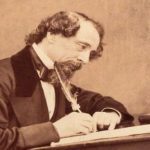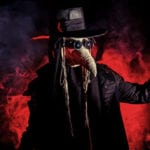 Movies and TV
Movies and TV  Movies and TV
Movies and TV  Creepy
Creepy 10 Eerie & Mysterious Ghosts of the Pacific Coast
 Weird Stuff
Weird Stuff 10 Typos That Accidentally Changed History
 History
History 10 Times Trickery Won Battles
 Technology
Technology 10 Awesome Upgrades to Common Household Items
 Misconceptions
Misconceptions 10 Hilarious (and Totally Wrong) Misconceptions About Childbirth
 Weird Stuff
Weird Stuff 10 Warning Labels That Exist Because Someone Actually Tried It
 Health
Health Ten Confounding New Inventions from the World of Biomedicine
 Creepy
Creepy 10 Death Superstitions That Will Give You the Creeps
 Movies and TV
Movies and TV 10 Movies That Get Elite Jobs Right, According to Experts
 Movies and TV
Movies and TV 10 Most Realistic Medical TV Shows of All Time
 Creepy
Creepy 10 Eerie & Mysterious Ghosts of the Pacific Coast
 Weird Stuff
Weird Stuff 10 Typos That Accidentally Changed History
Who's Behind Listverse?

Jamie Frater
Head Editor
Jamie founded Listverse due to an insatiable desire to share fascinating, obscure, and bizarre facts. He has been a guest speaker on numerous national radio and television stations and is a five time published author.
More About Us History
History 10 Times Trickery Won Battles
 Technology
Technology 10 Awesome Upgrades to Common Household Items
 Misconceptions
Misconceptions 10 Hilarious (and Totally Wrong) Misconceptions About Childbirth
 Weird Stuff
Weird Stuff 10 Warning Labels That Exist Because Someone Actually Tried It
 Health
Health Ten Confounding New Inventions from the World of Biomedicine
 Creepy
Creepy 10 Death Superstitions That Will Give You the Creeps
 Movies and TV
Movies and TV 10 Movies That Get Elite Jobs Right, According to Experts
10 Early Horror Novels with Intriguing Backstories
The horror novels on this list are among the earliest written. In fact, we begin with the first novel of the genre. Some of these works are by English or British writers, others by their Irish, Scottish, or American counterparts. Many of these authors’ books are familiar, even famous, but well-known or not, all of them are based on stories that are intriguing in themselves.
Related: Top 10 Chilling Horror Novels to Read in the Winter
10 The Castle of Otranto (1764)
Unlike his father and elder brothers, Horace Walpole (1717–1797), the 4th Lord of Orford, would become better remembered for his literary pursuits than for politics. The Castle of Otranto is generally regarded as the first horror novel. The novel focuses on Manfred, the lord of the castle, as he seeks to avert an ancient prophecy by marrying his dead son’s betrothed, Isabella, to produce another male heir. Walpole’s eerie account of the apparently haunted castle influenced other writers of horror, including one on this list: Matthew Gregory Monk.
Walpole himself was inspired by a number of earlier authors, including William Shakespeare, and by folklore. His own novel, it seems, even inspired Walpole himself to build Strawberry Hill House, a “Gothic revival villa” in Twickenham, a project that took 27 years. Although the house resembles a castle, influences on its architectural features were eclectic; elements of its design were borrowed from castles and cathedrals as well as tombs at Westminster Abbey.[2]
9 The History of the Caliph Vathek (1786)
Especially during the 18th century, Westerners were intrigued by the artifacts of Asian culture. William Beckford’s (1760-1844) horror novel The History of the Caliph Vathek catered to this preoccupation, its title referring to a Muslim religious and political leader, its setting to Samarah, or Samarra. But Vathek’s depiction of Gothic elements, which became popular due to Walpole’s earlier novel, also made Beckford’s book fashionable. The inclusion of the caliph, a jinn, a demon, and eunuchs satisfied readers’ interests in both Asian culture and Gothic horror.
As Richard Daniel Altick explains, Beckford had “celebrated his coming of age the preceding summer with a tremendous three-day fête at Fonthill [Abbey and] had determined to outdo himself with a Christmas revel.” To a friend, he wrote that “every preparation is going forwards” and that painter and set designer extraordinaire Philip James Loutherbourgh could “suggest or contrive—to give our favourite apartments the strangeness and novelty of a fairy world.” The result, Beckford alleged, motivated him to write his lavish novel over a three-day period.[2]
8 Rebecca (1938)
According to a Vanity Fair article by Rosemary Counter, three characters in Daphne du Maurier’s (1907–1989) chilling novel Rebecca are based on people whom the author herself knew: the novel’s narrator, Rebecca’s husband Maxim de Winter (who owns the Manderley estate), and his housekeeper Mrs. Danvers.
Like Rebecca’s betrothal to Winter, du Maurier’s engagement to Sir Frederick Arthur Montague “Boy” Browning was short, the couple marrying three months after becoming engaged. Likely, du Maurier’s discovery of love letters by her husband to his former fiancée, Jeanette “Jan” Ricardo, and “letters or cards” by Ricardo to Browning inspired one source of the tortured romantic conflict at the center of the novel. It, in some ways, reflects that of du Maurier’s own sometimes stormy marriage to Browning.
The narrator, whom readers often perceive as having a same-sex fascination for Rebecca, may represent the author’s own lesbian inclinations, as it is known that du Maurier’s extramarital liaisons involved other women, including actress Gertrude Lawrence.
According to du Maurier’s son Kit Browning, Mrs. Danvers was suggested by a “tall, dark housekeeper” whose sinister appearance impressed du Maurier while, as a young woman, she stayed at Milton House.
The most fascinating feature of the novel is that Rebecca is not the complex, problematic love story for which it is usually mistaken, but, as her son Kit claimed du Maurier told him, it is “a study in jealousy” that is mirrored by Mrs. Danvers’s jealousy of the narrator’s love of Rebecca and the narrator’s jealousy of Rebecca’s love of Winter. The ghost of the story, so to speak, is not Rebecca herself as much as it is the green-eyed monster.[3]
7 The Picture of Dorian Gray (1891)
Critics see The Picture of Dorian Gray by Oscar Wilde (1854–1900) as being like Rebecca, a largely autobiographical novel which, also like du Maurier’s novel, is suggestive of its author’s homosexuality. Darragh McManus summarizes this view, writing that the “story of Dorian Gray is an unflinching meditation on moral corruption, the nature of the soul, [and] heaven and hell” that gets underway when narcissistic Dorian’s deal with the devil causes his portrait to age and show the effects of his sins while Dorian himself remains ever young and handsome.
Originally, the novel hinted, rather strongly, that Dorian was in love with (or, at least, attracted to and fascinated by) the hedonistic Lord Henry “Harry” Wotton, just as the painter of Dorian’s portrait, Basil Hallward, was enamored of Dorian. It also implied that Dorian’s sins were primarily of a homosexual variety.
The public understood the implications. Even though Wilde deleted some of the more scandalous allusions to Dorian’s forbidden love, contemporary critics condemned the novel as “a poisonous book” penned “for outlawed noblemen and perverted telegraph boys.” The telegraph boys apparently provided after-hours services as callboys for aristocrats in order to supplement their wages as General Post Office employees.[4]
6 The Strange Case of Dr. Jekyll and Mr. Hyde (1886)
Up to the moment he was hanged at age 47, William Brodie of Edinburgh managed to pass himself off as a worthy craftsman. His title, “Deacon” (conferred by virtue of his being the president of the Incorporation of Wrights, a local guild), added to his air of respectability. He not only made fine furniture, but due to his guild position, he also helped to govern the city. In secret, he was a thief, using his locksmithing skills to rob a bank of £800 in 1768.
Over the years, his criminal sideline generated a comfortable income until Brodie was captured, tried, convicted, and hanged before a crowd of 40,000 observers. The seemingly respectable life that Brodie had lived alongside that of a criminal is believed to have inspired Robert Louis Stevenson’s (1850–1894) novel The Strange Case of Dr. Jekyll and Mr. Hyde.[5]
5 The Woman in White (1860)
The ambiguity of a woman dressed in white intrigued painters, including Gustave Courbet and James McNeill Whistler; the poet Charles Baudelaire; and the novelist Wilkie Collins (1824–1889). Did such an image connote a goddess? A virgin? A fallen woman? A ghost?
This figure, as Whistler painted her, with his lover Joanna Hiffernan as his model, was an enigma, her white gown contrasting sharply with her fiery red hair. The painter himself informed his friend and fellow artist Henri Fantin-Latour that the figure represented a prostitute.
Anne Catherick, the woman in white of Collins’s novel, proved as sensational as the new genre of “sensation fiction” launched by his mystery, a type of narrative that is marked by “its electrifying, suspenseful, and sometimes horrific plots, as well as its unsavoury themes of intrigue, jealousy, murder, adultery, and the like.”[6]
4 The House of the Seven Gables (1851)
This Gothic novel by famed author Nathaniel Hawthorne (1804–1864) was published in April 1851. The House of the Seven Gables follows a New England family and their ancestral home. However, the Pyncheon family, actual residents of Salem, Massachusetts, were not the inspirations for the novel’s characters with whom they share the same name.
In fact, the Colonel Puncheon of the novel is, in part, a foil to the young Yankee maiden Phoebe, who, despite her “Yankeeness,” is marked by “commercial shrewdness and a restless mobility.” Phoebe “transforms the decayed house into a home [and] tames the Yankee commoner Holgtave, who is intent upon avenging the Pyncheon family’s victimization of his ancestor, the rightful heir of the property.”
The descendants of the actual Pyncheons, however, were not happy at Hawthorne’s use of the name, finding his characterization of the family derisive and contemptuous. Although the author tried to mollify them, stating that, in future editions of the book, the name might be changed and a “disclaimer” might appear in the preface, Hawthorne was so annoyed at his correspondence with the “Pyncheon jackasses” that he once suggested that his complete exchanges of letters with them be published.[7]
3 The Narrative of Arthur Gordon Pym of Nantucket (1838)
Several of the short stories of Edgar Allan Poe (1809–1849) are based on actual events; so is his only novel: The Narrative of Arthur Gordon Pym of Nantucket (1838). An adventurous sea tale, complete with shipwreck, mutiny, and cannibalism, the novel was based on several sources. But the eeriest fact about the book is that it was prophetic.
As a BBC article observes, “Poe summoned up in his story the same name of a man who, 50 years later in real life, would be shipwrecked and—exactly as had been described in the book—eaten by his fellow survivors.” A descendant of Richard Parker pointed out the uncanny similarities between the fate of Poe’s protagonist and that of his own ancestor. Parker was one of four shipwrecked survivors who ate a turtle before resorting to cannibalism, with Parker the victim. To be sure, this is a bizarre case of life imitating art.[8]
2 Frankenstein (1818)
It’s generally well known that ghost stories in the Fantasmagoriana book that Lord Byron, Percy Bysshe Shelley, and Mary Shelley (1797–1851) took turns reading during an 1816 seaside summer vacation led Byron to challenge the three each to pen a spooky story of his or her own. Mary’s tale, of course, later became Frankenstein; or, The Modern Prometheus (1818).
Although her novel’s gigantic creature might have been inspired by Johann August Apel’s story “Le Portraits de Famille” (“Family Portraits”) and by Friedrich August Schulze’s narrative “La Morte Fiancee” (“The Corpse Bride”), Shelley’s imagination also helped her to conceive her monster. In the preface to the 1831 edition of the book, she describes her process of envisioning the creature as being similar to the operation of phantasmagoria, a theatrical projection of special optical effects to frighten and amaze spectators.
She explains that her “imagination [flashed] successive images in [her] mind with a vividness far beyond the usual bounds of reverie [and she] saw—with shut eyes, but acute mental vision—the pale student of unhallowed arts kneeling beside the thing he had put together [and] the hideous phantasm of a man stretched out, and then, on the working of some powerful engine, show[ing] signs of life, and stir[ring] with an uneasy, half vital motion.”[9]
1 The Monk (1796)
Nick Groom, the editor of The Monk, describes Matthew Gregory Lewis’s 1796 novel as having something for everyone: “power and politics, seduction and betrayal, sex and violence, incarceration, torture, devil worship, and death.”
Both a tale of the monk Ambrosia’s fall from grace and an engaged couple’s romance, the novel had sources in both a book Lewis (1775–1818) read and a historical event he witnessed: the sexual debauchery and inhumanity of the Marquis de Sade’s Justine (1791) and the “bloodthirsty” upheaval of the French Revolution (1789-1799).[10]








